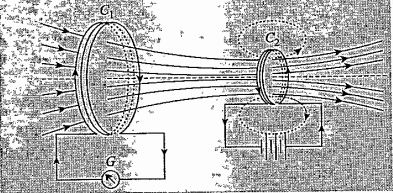ઉપરોક્ત દાખલામાં ધ્યાનમાં લીધેલો કણ ઈલેક્ટ્રોન હોય તેની સમક્ષિતિજ અચળ ઝડપ 2×106ms હોય તથા 0.5m નાં લંબઅંતરે રહેલી બે સમક્ષિતિજ પ્લેટો વચ્ચેના વિસ્તારમાં 9.1×102NC જેટલું વિદ્યુતક્ષેત્ર અધોદિશામાં આવેલું હોય તો આ ઈલેક્ટ્રોન ઉપરની ઘનભારિત પ્લેટને ક્યા સ્થાને અથડાશે તે શોધો. (m_e = 9.1 xx 10^-31 kg તથા e = 1.6 xx 10^-19 C)
Step by step video & image solution for ઉપરોક્ત દાખલામાં ધ્યાનમાં લીધેલો કણ ઈલેક્ટ્રોન હોય તેની સમક્ષિતિજ અચળ ઝડપ 2 xx 10^6 m/s હોય તથા 0.5 m નાં લંબઅંતરે રહેલી બે સમક્ષિતિજ પ્લેટો વચ્ચેના વિસ્તારમાં 9.1 xx 10^2 N/C જેટલું વિદ્યુતક્ષેત્ર અધોદિશામાં આવેલું હોય તો આ ઈલેક્ટ્રોન ઉપરની ઘનભારિત પ્લેટને ક્યા સ્થાને અથડાશે તે શોધો. (m_e = 9.1 xx 10^-31 kg તથા e = 1.6 xx 10^-19 C) by Physics experts to help you in doubts & scoring excellent marks in Class 12 exams.
Updated on:21/07/2023Topper's Solved these Questions
- વિદ્યુતભારો અને ક્ષેત્રો (ELECTRIC CHARGES AND FIELDS)BOOK - VIRAJ PUBLICATIONCHAPTER - વિદ્યુતભારો અને ક્ષેત્રો (ELECTRIC CHARGES AND FIELDS)EXERCISE - Example
67 Videos
- વિદ્યુતચુંબકીય પ્રેરણ (ELECTROMAGNATIC INDUCTION)BOOK - VIRAJ PUBLICATIONCHAPTER - વિદ્યુતચુંબકીય પ્રેરણ (ELECTROMAGNATIC INDUCTION)EXERCISE - Example
43 Videos
- સંદેશા વ્યવહાર તંત્રો (COMMUNICATION SYSTEMS)BOOK - VIRAJ PUBLICATIONCHAPTER - સંદેશા વ્યવહાર તંત્રો (COMMUNICATION SYSTEMS)EXERCISE - Example
11 Videos
Similar Questions
પદાર્થ 1 માંથી પદાર્થ 2 તરફ પ્રતિ સેકન્ડે 109 ઇલેક્ટ્રોન્સ વહન પામે તો કેટલા સમયને અંતે પદાર્થ 2 પરનો વિદ્યુતભાર 1 C જેટલો બનશે ?
View Solutionઆપેલ આકૃતિમાં દર્શાવેલી ગોઠવણ ધ્યાનમાં લો. ગેલ્વેનોમીટરમાં મોટું કોણીય આવર્તન મેળવવા માટે તમે શું કરશો ?

View Solutionપ્રુથ્વીની સપાટીથી 32 m ઊંચાઈ ધરાવતા ટ્રાન્સમીટર એન્ટેના તથા 50 m ઊચાઈ ધરાવતા રીસીવર એન્ટેના વચ્ચેના કેટલા મહત્તમ અંતર સુધી તેમની વચ્ચે સંતોષકારક દ્રષ્ટિરેખા સંદેશા વ્યવહાર થઈ શકશે ? (પ્રુથ્વીની ત્રિજ્યા 6.4×106m છે.)
View Solutionde-Brogile wavelength of an electron accelerated by a voltage of 50 V is close to ( |e| = 1.6 xx 10^(-19)C, m_(e) = 9.1 xx 10^(-31) kg, h = 6.6 xx 10^(-34) Js) :-
View SolutionIf mass of the electron = 9.1 xx 10^(–31) Kg. Charge on the electron = 1.6 xx 10^(–19) coulomb and g = 9.8 m//s^(2) . Then the intensity of the electric field required to balance the weight of an electron is-
View SolutionCalculate the product of the uncertainties of displacement and velocity of a moving electron having a mass of 9.1 xx 10^(-28) g . Given : h = 6.626 xx 10^(-34) kg m^2 s^(-1) m = 9.1 xx 10^(-28) g = 9.1 xx 10^(-31) kg
View SolutionSuppose that the particle in Question 1.33 is an electron projected with velocity vx=2.0×106ms−1 .If E between the plates separated by 0.5 cm is 9.1×102N/C , where will the electron strike the upper plate ? (|e|=1.6×10−19C,me=9.1×10−31kg)
View SolutionThe de Broglie wavelength of an electron accelerated by a voltage of 50V is closed to
|e|=1.6×10−19c,me=9.1×1031kg,h=6.6×10−34Js
View Solution50V की वोल्टता से त्वरित एक इलेक्ट्रॉन की डी-ब्रोग्ली तरंगदैर्ध्य निकटतम है:
(|e|=1.6×10−19C,me=9.1×10−31kg,h=6.6×10−34Js)
View SolutionAn electron having mass (9.1 xx 10^(-31) kg) and charge (1.6 xx 10^(-19)C) moves in a circular path of radius 0.5 m with a velocity 10^(6) m"/"s in a magnetic field. Strength of magnetic field is
View SolutionSuppose that the particle is an electron projected with velocity v_x = 2.0 xx 10^6 m s^-1 . If E between the plates separated by 0.5 cm is 9.1 xx 10^2N//C , where will the electron strike the upper plate? (|e| =1.6 xx 10^-19 C, m_e=9.1 xx 10^-31 kg.)
View SolutionGiven the electronic charge, e=1.6×10−19C,e≤ctronicmass,m = 9.1 xx 10^(-19) kg, h = 6.6 xx 10^(-34) J-sandc = 3 xx 10^8 m//s
The radius of the first orbit of electron in hydrogen atom is
View Solutionएक प्रकोष्ठ में 6.5G(1G=10−4T) का एकसमान चुंबकीय क्षेत्र बनाए रखा गया है। इस चुंबकीयक्षेत्र में एक इलेक्ट्रॉन 4.8×106ms−1 के वेग से क्षेत्र के लंबवत भेजा गया है। वृत्ताकार कक्षा की त्रिज्या ज्ञात कीजिए। (e=1.6×10−19C,me=9.1×10−31kg
View Solutionde-Brogile wavelength of an electron accelerated by a voltage of 50V is close to (|e|=1.6×10−19C,me=9.1×10−31 kg, h=6.6×10−34 Js) :-
View SolutionMolar mass of electron is nearly : (NA=6×1023),
mass of e− = 9.1 ×10−31Kg
View Solution
